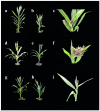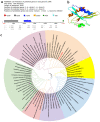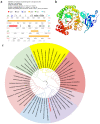Analysis of QTLs and Candidate Genes for Tassel Symptoms in Maize Infected with Sporisorium reilianum
- PMID: 36430897
- PMCID: PMC9692487
- DOI: 10.3390/ijms232214416
Analysis of QTLs and Candidate Genes for Tassel Symptoms in Maize Infected with Sporisorium reilianum
Abstract
Heat smut is a fungal soil-borne disease caused by Sporisorium reilianum, and affects the development of male and female tassels. Our previous research found that the tassel symptoms in maize infected with Sporisorium reilianum significantly differed in inbred lines with Sipingtou blood, and exhibited stable heredity over time at multiple locations. In this study, cytological analysis demonstrated that the cellular organization structures of three typical inbred lines (Huangzao4, Jing7, and Chang7-2) showed significant discrepancies at the VT stage. QTLs that control the different symptoms of maize tassels infected with Sporisorium reilianum were located in two F2 populations, which were constructed using three typical inbred lines. The BSA (bulked segregation analysis) method was used to construct mixed gene pools based on typical tassel symptoms. The QTLs of different symptoms of maize tassels infected with Sporisorium reilianum were detected with 869 SSR markers covering the whole maize genome. The mixed gene pools were screened with polymorphic markers between the parents. Additional SSR markers were added near the above marker to detect genotypes in partially single plants in F2 populations. The QTL controlling tassel symptoms in the Huangzao4 and Jing7 lines was located on the bin 1.06 region, between the markers of umc1590 and bnlg1598, and explained 21.12% of the phenotypic variation with an additive effect of 0.6524. The QTL controlling the tassel symptoms of the Jing7 and Chang7-2 lines was located on the bin 2.07 region, between the markers of umc1042 and bnlg1335, and explained 11.26% phenotypic variation with an additive effect of 0.4355. Two candidate genes (ZmABP2 and Zm00001D006403) were identified by a conjoint analysis of label-free quantification proteome sequencings.
Keywords: QTL; Sporisorium reilianum; bulked segregation analysis; maize; tassel symptoms.
Conflict of interest statement
The authors declare no conflict of interest.
Figures








Similar articles
-
Physiological Mechanisms Underlying Tassel Symptom Formation in Maize Infected with Sporisorium reilianum.Plants (Basel). 2024 Jan 15;13(2):238. doi: 10.3390/plants13020238. Plants (Basel). 2024. PMID: 38256790 Free PMC article.
-
Sporisorium reilianum infection changes inflorescence and branching architectures of maize.Plant Physiol. 2011 Aug;156(4):2037-52. doi: 10.1104/pp.111.179499. Epub 2011 Jun 8. Plant Physiol. 2011. PMID: 21653782 Free PMC article.
-
Performing Infection Assays of Sporisorium reilianum f. sp. Zeae in Maize.Methods Mol Biol. 2022;2494:291-298. doi: 10.1007/978-1-0716-2297-1_20. Methods Mol Biol. 2022. PMID: 35467215
-
Genetic Structure and Molecular Mechanisms Underlying the Formation of Tassel, Anther, and Pollen in the Male Inflorescence of Maize (Zea mays L.).Cells. 2022 May 26;11(11):1753. doi: 10.3390/cells11111753. Cells. 2022. PMID: 35681448 Free PMC article. Review.
-
Genetic and Molecular Mechanisms of Quantitative Trait Loci Controlling Maize Inflorescence Architecture.Plant Cell Physiol. 2018 Mar 1;59(3):448-457. doi: 10.1093/pcp/pcy022. Plant Cell Physiol. 2018. PMID: 29420811 Review.
Cited by
-
Physiological Mechanisms Underlying Tassel Symptom Formation in Maize Infected with Sporisorium reilianum.Plants (Basel). 2024 Jan 15;13(2):238. doi: 10.3390/plants13020238. Plants (Basel). 2024. PMID: 38256790 Free PMC article.
-
Extraction Optimization, Structural Analysis, and Potential Bioactivities of a Novel Polysaccharide from Sporisorium reilianum.Antioxidants (Basel). 2024 Aug 8;13(8):965. doi: 10.3390/antiox13080965. Antioxidants (Basel). 2024. PMID: 39199211 Free PMC article.
References
-
- Wang Y., Bao J., Wei X., Wu S., Fang C., Li Z., Qi Y., Gao Y., Dong Z., Wan X. Genetic structure and molecular mechanisms underlying the formation of tassel, Anther, and pollen in the male inflorescence of maize (Zea Mays L.) Cells. 2022;11:1753–1783. doi: 10.3390/cells11111753. - DOI - PMC - PubMed
-
- Li Y., Wu X., Jaqueth J., Zhang D., Cui D., Li C., Hu G., Dong H., Song Y., Shi Y., et al. The identification of two head smut resistance-related QTL in maize by the joint approach of linkage mapping and association analysis. PLoS ONE. 2015;10:e0145549. doi: 10.1371/journal.pone.0145549. - DOI - PMC - PubMed
-
- Berke T.G., Rocheford T.R. Quantitative trait loci for tassel traits in maize. Crop Sci. 1999;39:1439–1443. doi: 10.2135/cropsci1999.3951439x. - DOI
MeSH terms
Supplementary concepts
Grants and funding
LinkOut - more resources
Full Text Sources
Miscellaneous

